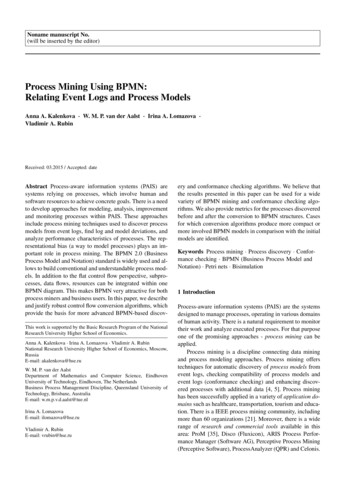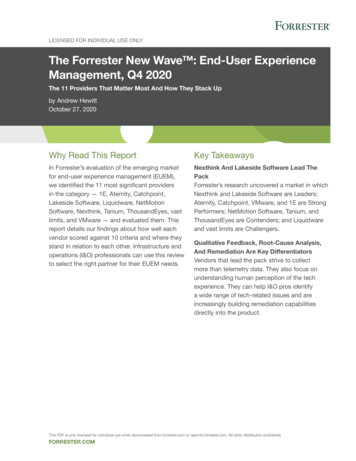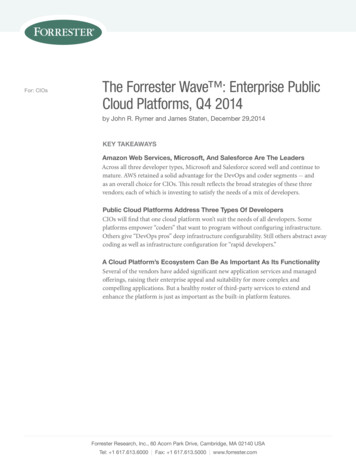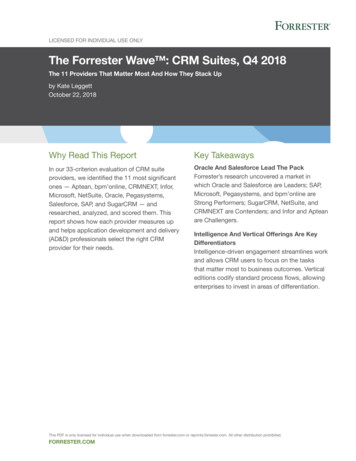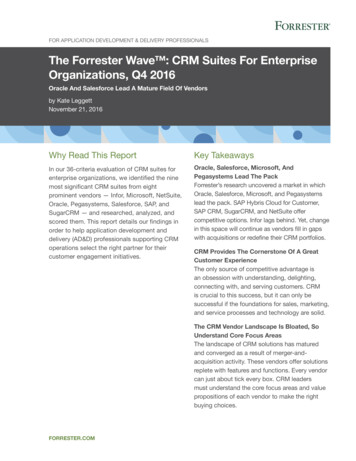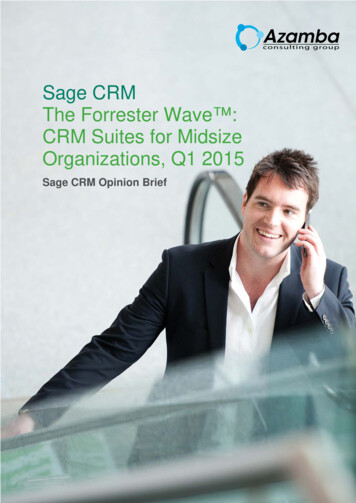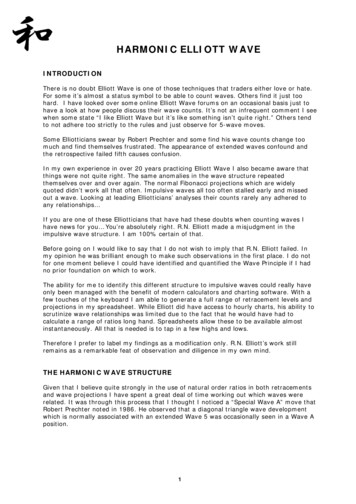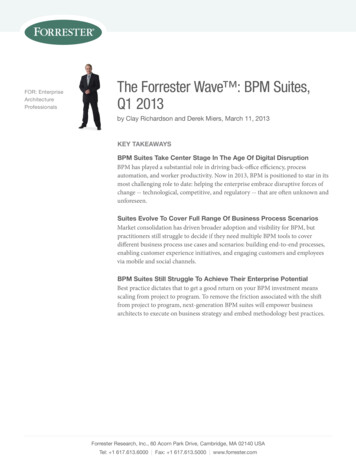
Transcription
For: EnterpriseArchitectureprofessionalsThe Forrester Wave : BPM Suites,Q1 2013by clay richardson and Derek Miers, March 11, 2013key TakeaWaysBpM suites Take Center stage in The age of digital disruptionBPM has played a substantial role in driving back-office efficiency, processautomation, and worker productivity. Now in 2013, BPM is positioned to star in itsmost challenging role to date: helping the enterprise embrace disruptive forces ofchange -- technological, competitive, and regulatory -- that are often unknown andunforeseen.suites evolve To Cover Full Range of Business process scenariosMarket consolidation has driven broader adoption and visibility for BPM, butpractitioners still struggle to decide if they need multiple BPM tools to coverdifferent business process use cases and scenarios: building end-to-end processes,enabling customer experience initiatives, and engaging customers and employeesvia mobile and social channels.BpM suites still struggle To achieve Their enterprise potentialBest practice dictates that to get a good return on your BPM investment meansscaling from project to program. To remove the friction associated with the shiftfrom project to program, next-generation BPM suites will empower businessarchitects to execute on business strategy and embed methodology best practices.Forrester research, inc., 60 Acorn park Drive, cambridge, MA 02140 usAtel: 1 617.613.6000 Fax: 1 617.613.5000 www.forrester.com
For Enterprise Architecture ProfessionalsMarch 11, 2013The Forrester Wave : BPM Suites, Q1 2013How The Top 10 Vendors Stack Up For Next-Generation BPM Suitesby Clay Richardson and Derek Mierswith Alex Cullen and Julian KeenanWhy Read This ReportIn Forrester’s 59-criteria evaluation of business process management (BPM) suite vendors, we identifiedthe 10 most significant software providers in the category — Appian, Bizagi, Cordys, HandySoft, IBM,OpenText, Oracle, Pegasystems, Software AG, and Tibco Software — and researched, analyzed, and scoredthem. This report details our findings about how well each vendor fulfills our criteria and where they standin relation to each other to help enterprise architects select the right solution to support launching andscaling enterprisewide BPM programs and initiatives.Table Of ContentsNotes & Resources2 BPM Suites Take Center Stage In The Age OfDigital DisruptionForrester conducted product demos,strategy sessions, and customer referenceinterviews for nine vendors in the BPM suitesmarket: Appian, Bizagi, Cordys, HandySoft,IBM, OpenText, Pegasystems, Software AG,and Tibco Software.Suites Evolve To Support Full Range OfBusiness Process Use CasesBut BPM Suites Often Struggle To Play ABlockbuster Role Across The Enterprise6 BPM Suites Evaluation OverviewRelated Research DocumentsEvaluation Criteria Focus On Broad Support ForScaling BPM ProgramsPrepare For 2013’s Shifting BPM LandscapeJanuary 23, 2013Forrester Selected Vendors According ToProduct Scope And Global SuccessAccelerate Business Change With The RightBPM Tools And TechnologiesDecember 13, 201211 Evaluation Analysis13 Vendor ProfilesThe ROI Of BPM SuitesAugust 22, 2011Leaders Blur Lines Between Experience Designand Process DesignStrong Performers Offer Unique Approaches ToOvercoming BPM Complexity18 Supplemental Material 2013, Forrester Research, Inc. All rights reserved. Unauthorized reproduction is strictly prohibited. Information is based on best availableresources. Opinions reflect judgment at the time and are subject to change. Forrester , Technographics , Forrester Wave, RoleView, TechRadar,and Total Economic Impact are trademarks of Forrester Research, Inc. All other trademarks are the property of their respective companies. Topurchase reprints of this document, please email clientsupport@forrester.com. For additional information, go to www.forrester.com.
For Enterprise Architecture Professionals2The Forrester Wave : BPM Suites, Q1 2013bpm suites take center stage in The age of digital disruptionLike a seasoned actor, BPM has starred in many different roles across the enterprise over the pastdecade. In its inaugural role, BPM teamed up with document imaging and workflow to automateand streamline paper-intensive business process.1 Since then, BPM has evolved to tackle moresubstantial business challenges, with an emphasis on driving back-office efficiency, processautomation, and worker productivity. In 2013, BPM is positioned to star in its most challenging roleto date: helping the enterprise embrace and adapt to disruptive forces of change — technological,competitive, and regulatory — that are often unknown and unforeseen (see Figure 1).Figure 1 Enterprises Continue To Ramp Investment In Business Process Management ToolsWhat are your firm’s plans to adopt the following technologies?(business process management tools)Interested but no plans30%Planning to implement27%Implemented or expanding26%Not interestedDon’t know13%4%Base: 520 IT decision-makersSource: Forrsights Budgets And Priorities Tracker Survey, Q4 201288581Source: Forrester Research, Inc.Suites Evolve To Support Full Range Of Business Process Use CasesOver the past five years, the BPM suites space has gone through multiple waves of consolidation.The most recent consolidation came in the form of larger BPM players swallowing up smallerplayers to gain a greater share of the BPM market. Although market consolidation helped drivebroader adoption and awareness for BPM, enterprise architects still struggle whether they needmultiple BPM tools to cover different business process use cases and scenarios, as they seek to: Build end-to-end processes that span DCM, BPM, and straight-through processing.Historically, Forrester has tracked BPM software across three different market segments:document-centric BPM suites, human-centric-BPM suites, and integration-centric BPM suites.2However, through market consolidation these three segments are merging into a single BPMsuite offering that can cover three different work patterns: dynamic case management (DCM),human workflow, and straight-through processing.3 These unified BPM suites now provide 2013, Forrester Research, Inc. Reproduction ProhibitedMarch 11, 2013
For Enterprise Architecture Professionals3The Forrester Wave : BPM Suites, Q1 2013single design and development environments for building and deploying end-to-end businessprocesses that incorporate multiple process patterns and use cases (see Figure 2). Design customer experiences from the outside in. No longer relegated to the back-office,BPM today plays a critical role in driving customer experience initiatives.4 These initiativesrange from companies looking to overhaul customer service processes to companies seeking todeliver more compelling experiences that incorporate big data analytics and real-time guidance.Leading BPM suite vendors are beginning to blur the line between customer experience designand business process design. In some cases, vendors allow enterprise architects and businessarchitects to take an “experience-first” approach to business process transformation.5 Instead offocusing on the process model first, these solutions allow teams to define process change basedon the customer experience. Engage customers and employees through mobile and social channels. The way we get workdone has changed significantly over the past few years. Increasingly, workers and customersexpect to engage with companies via mobile applications and social channels.6 BPM suites haveembraced these digital disruptors, with nearly all vendors now offering some level of support forgetting work done while on the go. Additionally, BPM suites now provide social work interfacesthat allow customers and employees to easily “follow” a given process and quickly identifyexperts for a given business process or task.Figure 2 BPM Suites Evolve To Support Full Spectrum Of Process Use CasesDynamic case management and dynamic BPM enableknowledge worker processes and d hocexceptionhandlingTruly uniqueexceptionsTraditional BPM and workflow88581 2013, Forrester Research, Inc. Reproduction ProhibitedSource: Forrester Research, Inc.March 11, 2013
For Enterprise Architecture Professionals4The Forrester Wave : BPM Suites, Q1 2013But BPM Suites Often Struggle To Play A Blockbuster Role Across The EnterpriseLet’s face it, investing in BPM — both the practice and the technology — does not come cheap.Average startup costs for initial software licenses run between 250,000 to 300,000, with additionalupfront investment in training and infrastructure.7 The assumption has always been that theonly way to get a good return on your investment in BPM is to scale the initiative from project toprogram. The mantra for BPM has always been “start small, think big, move fast!” However, mostteams hit a brick wall when it comes to the “moving fast” part of the equation. While they might beable to achieve quick wins with the first two or three departmental projects, the shift to enterpriseis often hampered by the technology being typecast as a tactical tool, unable to shift into a morestrategic role.Some enterprise architects and business architects argue that BPM suite software has a limited role toplay in helping teams evolve from project to program. However, in order to remove the frictionassociated with moving from project to program, the next generation of BPM suites will (see Figure 3): Empower business architects to design and execute on process strategy. Business architectsare playing a broader role in driving business change initiatives. In many cases, these architectsfocus on defining the strategy for transforming end-to-end business processes. Historically,BPM tools offered very little to help these strategists scope and manage large-scale changeprojects. This disconnect between strategy and execution keeps BPM suites isolated to the CIO’soffice, without a way to have a greater impact on enterprise strategy. Remove upfront barriers to rapid development with cloud models. Initial deployment forBPM suites is often hampered by the need to stand up and configure new infrastructure forinstalling the software. Many teams now remove this friction point for BPM by deploying initialprojects using the BPM suite vendor’s cloud environment (see Figure 4). This allows teams torealize immediate impact for BPM and also demonstrates to business stakeholders that they cansee rapid return on investment without technology becoming a hurdle. Embed program and method support to provide the right guiderails. One of the mostcommon complaints we hear from BPM teams is how difficult it can be to adopt best practicesfor scaling BPM from siloed projects into high-impact, enterprisewide change programs.Leading BPM suite vendors are now beginning to embed project and program best practicesdirectly into their software platforms, instead of leaving this knowledge buried in 5,000-pagered books and online knowledge bases. Without these embedded guiderails, BPM teams usuallyend up relying heavily on the vendor — or the vendor’s implementation partners — for longterm support for implementing the product correctly.8 2013, Forrester Research, Inc. Reproduction ProhibitedMarch 11, 2013
For Enterprise Architecture Professionals5The Forrester Wave : BPM Suites, Q1 2013Figure 3 Common Friction Points For Moving BPM From Project To nizationArchitecture88581 2013, Forrester Research, Inc. Reproduction ProhibitedSource: Forrester Research, Inc.March 11, 2013
For Enterprise Architecture Professionals6The Forrester Wave : BPM Suites, Q1 2013Figure 4 Many BPM Programs Either Plan To Use Software-As-A-Service Or Already Do So“What are your firm’s plans to use software-as-a-service (SaaS) to complementor replace your business process management software?”Don’t know/does not apply6%“Already replaced most/all with SaaS”or “Plan to replace most/all withSaaS within two years”15%No plans to use SaaS46%“Plan to complement with some SaaSwithin two years” or “Using some SaaSto complement”33%Base: 520 global business decision-makersSource: Forrsights Business Decision-Makers Survey, Q4 201288581Source: Forrester Research, Inc.BPM SUITES EVALUATION OverviewEven with market consolidation, the BPM suite space is still a crowded stage. At last count, Forresteridentified 52 different vendors competing in the broader BPM market, covering BPM suites,DCM, and integration suites (see Figure 5). With such a wide variety of vendors to choose from,companies evaluating BPM suites should spend time assessing their unique business process needsto develop the right shortlist of vendors to consider. 2013, Forrester Research, Inc. Reproduction ProhibitedMarch 11, 2013
For Enterprise Architecture Professionals7The Forrester Wave : BPM Suites, Q1 2013Figure 5 Business Process Management Market Continues To Be A Crowded StageThe Forrester Wave :Business Process ManagementSuites, Q3 2010This report focuses on BPM suitevendors formerly covered under“human-centric” BPM suites.The Forrester Wave:Comprehensive IntegrationSolutions, Q4 2010This report focuses on integrationvendors formerly covered under“integration-centric” BPM suites.BPM suites AgilePoint Appway AuraPortal Bizagi BluespringSoftware Bonitasoft Colosa Intalio Mobideo K2 PNMsoft PolymitaTechnologies Ultimus W4Integration suites Aurea (Savvion) DST Systems Fujitsu OpenText Red Hat Software AG Tibco Software Active Endpoints Axway Bosch SoftwareInnovations iWay Software Microgen SAP Seeburger Vitria IBM Kofax Microsoft Lexmark Oracle Nintex OpenText Appian OpenText Cordys Pegasystems SAP EMC HandySoft Kana SoftwareDCM suites ActionBase Adobe Systems Autonomy Be Informed Hyland Software ISIS Papyrus Newgen Software Whitestein TechnologiesThe Forrester Wave:Dynamic CaseManagement, Q1 2011This report focuseson case managementvendors.Source: January 23, 2013, “Prepare For 2013’s Shifting BPM Landscape” Forrester report88581 2013, Forrester Research, Inc. Reproduction ProhibitedSource: Forrester Research, Inc.March 11, 2013
For Enterprise Architecture Professionals8The Forrester Wave : BPM Suites, Q1 2013Evaluation Criteria Focus On Broad Support For Scaling BPM ProgramsAfter examining past research, hundreds of client inquiries, and vendor and expert interviews, wedeveloped a comprehensive set of evaluation criteria. We evaluated vendors against 59 criteria,which we grouped into three high-level buckets: Current offering. In this category, we looked at product architecture, work management,authoring environment, supported work patterns (dynamic case management, humanworkflow, and straight-through processing), and embedded support for business architectureand program management. Strategy. In this category, we took a close look at each vendor’s product strategy and road map,approach to program enablement, and overall corporate strategy. In particular, we focused onevaluating which vendors had compelling road maps that focused on removing complexityfrom implementing BPM, in addition to investing in improving the overall design and usabilityof the product. Market presence. In this category, we looked at the install base of customers using the vendor’sBPM suite product, how much revenue is attributed to the vendor’s BPM suite offering, the levelof research and development (R&D) resources dedicated to the product, and the size of thepartner ecosystem capable of implementing the product.Forrester Selected Vendors According To Product Scope And Global SuccessTo help you create a solid shortlist of candidates, Forrester evaluated the strengths and weaknessesof leading BPM suite vendors. We then identified the top 10 vendors for deeper evaluation basedon their support for the full scope of business process use cases and patterns, including supportfor dynamic case management, human workflow, and straight-through processing (see Figure 6).Additionally, we selected vendors based on their product’s support for scaling BPM initiatives fromproject to program. We included nine vendors and their products in our detailed evaluation: Appian,Bizagi, Cordys, HandySoft, IBM, OpenText, Pegasystems, Software AG, and Tibco Software.Although Oracle chose not to participate in this Forrester Wave evaluation, we evaluated its BPMsuite offering based on our knowledge from past analysis and publicly available information toprovide a complete picture of the competitive landscape. Each of the vendors selected broadly metall of the following qualification criteria: Support for DCM, human workflow, and straight-through processing. All of the vendorsin this evaluation can support the three most common use cases for BPM: dynamic casemanagement, human workflow, and straight-through processing. However, this does not meanthat all vendors must or can offer exactly the same approach or the same functional depth foreach use case. 2013, Forrester Research, Inc. Reproduction ProhibitedMarch 11, 2013
For Enterprise Architecture Professionals9The Forrester Wave : BPM Suites, Q1 2013 Embedded support for scaling initiatives from project to program. BPM teams increasinglyrely on vendors for knowledge transfer to quickly ramp up on skills and best practices forbuilding sustainable BPM programs. To help accelerate program enablement, BPM suitesmust provide the right guiderails to help teams design and execute their program. In short,BPM suites are beginning to evolve to support the broader BPM program and not just thedevelopment and analysis aspects of BPM. Global delivery track record and capability. Vendors had to deliver BPM projects for clients inat least four of the seven regions of the world in 2011: North America, South America, CentralAmerica, Europe, Africa, the Middle East, and Asia Pacific. A significant number of clientinstallations had to be included in both North America and Europe. This qualification criterionensures that vendors participated in this evaluation with both a competitive current offeringand the ability to deliver across the globe. Mindshare within Forrester’s client base. Included vendors are frequently mentioned inForrester client inquiries and other forms of client interaction. 2013, Forrester Research, Inc. Reproduction ProhibitedMarch 11, 2013
For Enterprise Architecture Professionals10The Forrester Wave : BPM Suites, Q1 2013Figure 6 Evaluated Vendors: Product Information And Selection CriteriaProduct versionevaluatedVersionrelease dateVendorProduct evaluatedAppianAppian 77November 2012BizagiBizagi Go10December 2012CordysCordys Business Operations Platform4.2October 2012HandysoftBizFlow Plus12June 2012IBMIBM Business Process Manager8December 2012OpenTextMBPMOracleOracle Business Process Management Suite 11gPegasystemsPega BPMSoftware AGwebMethods BPM Suite, ARIS Enterprise,ARISalignTibco SoftwareActiveMatrix BPM9.2August 201211.1.1.6February 20126.3December 20128.2, 7.2, 1.02April 2011,March 2012,March 2010November 2012Vendor selection criteriaSupport for DCM, human workflow, and straight-through processing. All of the vendors in thisevaluation can support the three most common use cases for business process management (BPM):dynamic case management, human workflow, and straight-through processing. However, this does notmean that all vendors must or can offer exactly the same approach or the same functional depth for eachuse case.Embedded support for scaling initiatives from project to program. BPM teams increasingly rely onvendors for knowledge transfer to quickly ramp up on skills and best practices for building sustainableBPM programs. To help accelerate program enablement, BPM suites must provide the right guiderails tohelp teams design and execute their program. In short, BPM suites are beginning to evolve to support thebroader BPM program and not just the development and analysis aspects of BPM.Global delivery track record and capability. Vendors had to deliver BPM projects for clients in at leastfour of the seven regions of the world in 2011: North America, South America, Central America, Europe,Africa, the Middle East, and Asia Pacific. A significant number of client installations had to be included inboth North America and Europe. This qualification criterion ensures that vendors participated in thisevaluation with both a competitive current offering and the ability to deliver across the globe.Mindshare within Forrester's client base. Included vendors are frequently mentioned in Forrester clientinquiries and other forms of client interaction.Source: Forrester Research, Inc. 2013, Forrester Research, Inc. Reproduction ProhibitedMarch 11, 2013
For Enterprise Architecture ProfessionalsThe Forrester Wave : BPM Suites, Q1 201311evaluation analysisThe evaluation uncovered a market in which (see Figure 7): Appian, IBM, and Pegasystems lead the pack. “Look and feel” might seem trivial factors whenselecting a BPM suite. However, providing a consistent user interface across different suitecomponents — which each of these leading vendors do — goes a long way toward helping teamsextend the reach and impact of BPM suites across the enterprise. Additionally, each of thesevendors has done an impressive job embedding BPM methods and program support features intotheir products. Pegasystems and Appian both provide native support for modeling and executingdynamic case management, human workflow, and straight-through-processing scenarios. Bizagi, Cordys, HandySoft, OpenText, Oracle, Software AG, and Tibco are competitive. TheStrong Performer category has a wide range of vendors. Software AG and OpenText are largervendors with BPM suite platforms that bridge the gap between strategy and execution. Cordysand Bizagi offer innovative approaches to incorporating and synchronizing master data betweenbusiness processes and legacy source systems.Oracle and Tibco Software provide best-in-class functionality for integration business processeswith back-end systems and service-oriented architectures. HandySoft’s BPM suite allowsteams to get started with BPM at an attractive price point while being able to scale to supportsophisticated use cases, including DCM, human workflow, and straight-through-processing.This evaluation of the BPM suite market is intended to be a starting point only. We encourage clientsto view detailed product evaluations and adapt criteria weightings to fit their individual needsthrough the Forrester Wave Excel-based vendor comparison tool. 2013, Forrester Research, Inc. Reproduction ProhibitedMarch 11, 2013
For Enterprise Architecture Professionals12The Forrester Wave : BPM Suites, Q1 2013Figure 7 Forrester Wave : BPM Suites, Q1 ngPegasystemsGo online to downloadAppianSoftware AGthe Forrester Wave toolIBMfor more detailed productevaluations, featureTibco SoftwareOpenTextCurrentofferingcomparisons, andCordysOraclecustomizable rankings.BizagiHandySoftMarket presenceFull vendor participationIncomplete vendor participationWeakWeakStrategyStrongSource: Forrester Research, Inc. 2013, Forrester Research, Inc. Reproduction ProhibitedMarch 11, 2013
For Enterprise Architecture Professionals13The Forrester Wave : BPM Suites, Q1 oftIBMOpenTextPegasystemsSoftware AGTibco SoftwareFigure 7 Forrester Wave : BPM Suites, Q1 2013 (Cont.)CURRENT OFFERINGArchitectureWork managementAuthoring environmentWork patternsMethods roduct strategyProgram enablementCorporate strategyProduct RKET PRESENCEInstalled baseRevenueServicesEmployeesTechnology 04.004.003.004.002.381.603.002.002.004.00All scores are based on a scale of 0 (weak) to 5 (strong).Source: Forrester Research, Inc.Vendor ProfilesLeaders Blur Lines Between Experience Design And Process Design Appian shines with strong vision for social and mobile engagement. Appian’s BPM suiteplatform provides a completely web-based environment for modeling, designing, anddeveloping business process solutions. Since our 2010 BPM suite Wave evaluation, Appian hasextended its leadership position for mobile and social engagement.9Social engagement features are tightly integrated into the product in the form of social workstreams, which allow users to “follow” process instances, activities, and other process-relatedevents. One of the unique features of Appian’s social work stream is that users can take processrelated actions directly from work stream events, such as completing or reassigning tasks.Additionally, in the latest version of the product Appian provides a “records” view that allows 2013, Forrester Research, Inc. Reproduction ProhibitedMarch 11, 2013
For Enterprise Architecture Professionals14The Forrester Wave : BPM Suites, Q1 2013users to view different business objects (i.e., records) and processes associated with these objects.Users can also execute process-related actions from a given record or business object. IBM delivers a unified experience for building enterprise-scale programs. Just a few yearsago, IBM’s BPM offering consisted of a long list of cobbled together workflow, integration,business rules, and analytics products. In its latest release, IBM BPM has stitched all of thesedifferent components into a single offering by providing a consistent look and feel across theBPM stack. The result: a product that ticks all the key checkboxes and also provides a goodfoundation for collaboration across the different roles that make up BPM programs.In this latest release, IBM built up social collaboration features, with a focus on providing bestin-class support for expert location and real-time work collaboration. Expert location featuresallow users to quickly see a list of experts for a given process instance or work item. Users canrequest help from experts to assist with completing a particular work item. Once contacted,the users can collaborate in real-time to fill out forms or walk through the steps of how best tocomplete a task. Additionally, IBM BPM provides a centralized repository for managing andreusing process-related development artifacts. Pegasystems extends “build for change” to business stakeholders. Pegasystems continuesto lead with a strategic focus on delivering horizontal and vertical frameworks, built on topof its Pega BPM platform. Although the core BPM environment still requires a significantupfront investment in training and certification, arguably the platform lives up to its promiseof delivering business agility. Since acquiring Chordiant in 2010, Pegasystems has focused onmerging customer experience and process transformation software categories. Key to this shiftis Pegasystems’ “next-best-action” capability, which uses a sophisticated correlation engine topredict and recommend the next recommended step a user should take for a given process.10 Inmost cases, Pegasystems uses next-best-action to drive customer service interactions toward adesired or optimal outcome.While Pegasystems has a long track record as a leader in the BPM suite market, the vendor’soffering has always been tagged as developer centric, offering little functionality targetingnontechnical users and business architects. In the winter of 2012, Pegasystems unveiled a newcomponent, “business profiler,” which targets business architects and is designed to help teamsdefine, track, and manage the strategic aspects of delivering BPM. Based on the initial versionof the product shown to Forrester, Pegasystems has set a new standard for empowering businessarchitects to design and execute business change programs.Strong Performers Offer Unique Approaches To Overcoming BPM Complexity Bizagi offers a unique approach to marrying business processes and structured data.Although Bizagi has been in the BPM suite market for over a decade, this marks the vendor’s 2013, Forrester Research, Inc. Reproduction ProhibitedMarch 11, 2013
For Enterprise Architecture Professionals15The Forrester Wave : BPM Suites, Q1 2013debut in Forrester’s BPM suite Wave evaluation. Originally focused on the Latin Americanmarket, Bizagi has made significant progress expanding its client base in North American andEuropean markets. The vendor’s BPM suite environment provides a consistent look and feelacross all components and has established a track record around accelerating time-to-value fordelivering BPM solutions.A key differentiator for Bizagi is its unique data modeling approach that allows processdesigners to create a virtualized data model that provides a consistent way to manage andsynchronize between business process models and source data and legacy applications. Thisapproach allows process analysts and designers to minimize process model complexity. Insteadof embedding unnecessary process activities for orchestrating and synchronizing data updates,much of this complexity can be shifted into the virtualized data model.Additionally, Bizagi’s design environment provides advanced support for tailoring businessprocesses and forms for mobile devices. Specifically, the environment allows designers to createcustom mobile-enabled widgets that can be reused across business processes and web-based forms. Cordys provides a so
the Forrester Wave: BpM suites, 1 2013 6 2013, Forrester research, inc. reproduction prohibited March 11, 2013 Figure 4 Many BPM Programs Either Plan To Use Software-As-A-Service Or Already Do So 88581 Source: Forrester Research, Inc. "What are your rm's plans to use software-as-a-service (SaaS) to complement


